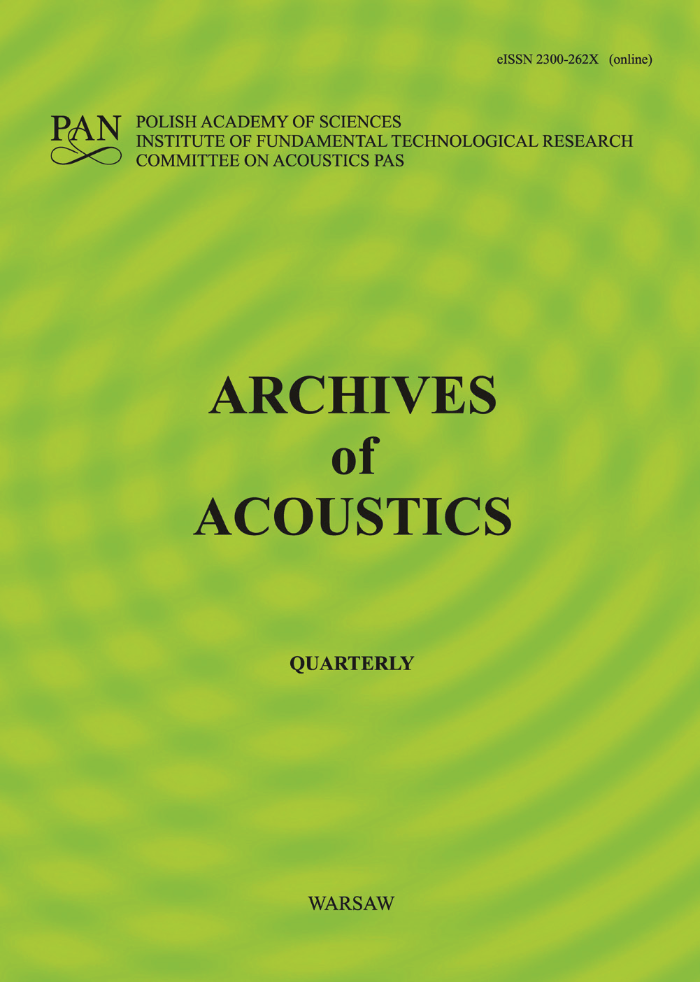Abstract
The acoustic emission method has been applied to the investigation of the dependence of the oxygen release in the Briggs-Rauscher oscillatory reaction on the rate of stirring. The oxygen distribution does not increase toward a limiting value but achieves a maximum and decreases afterwards. There exists a low stirring rate at which the release of oxygen from the solution proceeds in the form of "fountains". This can be observed before the disappearance of the iodine oscillations. The results obtained by the acoustic emission method can be useful in the description of the unknown mechanism of the Briggs-Rauscher reaction.References
[1] W.C. Bray, A periodic reaction in homogeneous solution and its relation to catalysis, J. Am. Chem. Soc., 43, 1262–1267 (1921).
[2] T.S. Briggs and W.C. Rauscher, An oscillating iodine clock, J. Chem. Educ., 50, 496 (1973).
[3] D.A. Franz, F. Feurguson and E. Boschmann, Superoxide dismutase and the Briggs-Rauscher reaction, J. Chem. Educ., 68, 57 (1991).
[4] A.L. Kawczyński, Reakcje chemiczne — od równowagi przez struktury dyssypatywne do chaosu, WNT, Warszawa 1990.
[5] M. Orlik, Reakcje oscylacyjne — porzadek i chaos, WNT, Warszawa 1996.
[6] O. Gurel and D. Gurel, Types of oscillations in chemical reactions, Academic Vlg., Berlin 1984.
[7] A.K. Dutt and S.C. Muller, Effect of stirring and temperature on the Belousov-Zhabotinsky reaction in a CSTR, J. Phys. Chem., 97, 10059–10063 (1993).
[8] P. Strizhak and M. Menzinger, Stirring effect on the bistability of the Belousov-Zhabotinsky reaction in a CSTR, J. Phys. Chem., 100, 19182–19186 (1996).
[9] R.M. Noyes, M.B. Rubin and P.G. Bowers, An alternative model for transport of molecules between gas and solution, J. Phys. Chem., 96, 1000–1005 (1992).
[10] E.H. White, An efficient chemiluminescent system and chemiluminescent clock reaction, J. Chem. Educ., 34, 275–276 (1957).
[11] J. Rzeszotarska, Application of acoustic emission as a method of quantitative chemical analysis, Acoustics Letters, 17, 151–155 (1994).
[12] J. Rzeszotarska, F. Rejmund and P. Ranachowski, Acoustic emission probes of foam drainage processes in H2O-C2H5OH-air systems with content of detergent triton X-100, Proc. Int. Symp. on Hydroacoustics, Jurata, 12-16 maj 1997.
[13] D. Betteridge, M.T. Joslin and T. Lilley, Acoustic emissions from chemical reactions, Anal. Chem., 53, 1064–1073 (1981).
[14] S.D. Furrow and R.M. Noyes, The oscillatory Briggs-Rauscher reaction, J. Am. Chem. Soc., 104, 38–42 (1982).
[15] A.K. Dutt and M. Menzinger, Effect of mixing mode and stirring rate on the bistability of the BrO−3 /Br−/Ce3+ system, J. Phys. Chem., 95, 3429–3432 (1991).
[16] I.R. Epstein, The consequences of imperfect mixing in autocatalytic chemical and biological systems, Nature, 374, 321–327 (1995).
[2] T.S. Briggs and W.C. Rauscher, An oscillating iodine clock, J. Chem. Educ., 50, 496 (1973).
[3] D.A. Franz, F. Feurguson and E. Boschmann, Superoxide dismutase and the Briggs-Rauscher reaction, J. Chem. Educ., 68, 57 (1991).
[4] A.L. Kawczyński, Reakcje chemiczne — od równowagi przez struktury dyssypatywne do chaosu, WNT, Warszawa 1990.
[5] M. Orlik, Reakcje oscylacyjne — porzadek i chaos, WNT, Warszawa 1996.
[6] O. Gurel and D. Gurel, Types of oscillations in chemical reactions, Academic Vlg., Berlin 1984.
[7] A.K. Dutt and S.C. Muller, Effect of stirring and temperature on the Belousov-Zhabotinsky reaction in a CSTR, J. Phys. Chem., 97, 10059–10063 (1993).
[8] P. Strizhak and M. Menzinger, Stirring effect on the bistability of the Belousov-Zhabotinsky reaction in a CSTR, J. Phys. Chem., 100, 19182–19186 (1996).
[9] R.M. Noyes, M.B. Rubin and P.G. Bowers, An alternative model for transport of molecules between gas and solution, J. Phys. Chem., 96, 1000–1005 (1992).
[10] E.H. White, An efficient chemiluminescent system and chemiluminescent clock reaction, J. Chem. Educ., 34, 275–276 (1957).
[11] J. Rzeszotarska, Application of acoustic emission as a method of quantitative chemical analysis, Acoustics Letters, 17, 151–155 (1994).
[12] J. Rzeszotarska, F. Rejmund and P. Ranachowski, Acoustic emission probes of foam drainage processes in H2O-C2H5OH-air systems with content of detergent triton X-100, Proc. Int. Symp. on Hydroacoustics, Jurata, 12-16 maj 1997.
[13] D. Betteridge, M.T. Joslin and T. Lilley, Acoustic emissions from chemical reactions, Anal. Chem., 53, 1064–1073 (1981).
[14] S.D. Furrow and R.M. Noyes, The oscillatory Briggs-Rauscher reaction, J. Am. Chem. Soc., 104, 38–42 (1982).
[15] A.K. Dutt and M. Menzinger, Effect of mixing mode and stirring rate on the bistability of the BrO−3 /Br−/Ce3+ system, J. Phys. Chem., 95, 3429–3432 (1991).
[16] I.R. Epstein, The consequences of imperfect mixing in autocatalytic chemical and biological systems, Nature, 374, 321–327 (1995).


